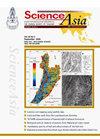Effects of different substrates on the growth and composition of periphyton in the low saline groundwater system
IF 0.6
4区 综合性期刊
Q3 MULTIDISCIPLINARY SCIENCES
引用次数: 1
Abstract
The growth and composition of periphyton in low saline groundwater (5 ppt) were evaluated using 5 different substrates: split bamboo poles (SBP), green shade net (GSN), high density polyethylene (HDPE) sheets, low density polyethylene (LDPE) sheets, and polyvinyl chloride (PVC) pipes). The effect of substrate type, submersion time, and depth was evaluated. The average submersion depth of all the substrates was maintained at 88.27 cm, and this trial was conducted for 60 days. Chlorophyll a, dry weight, ash, ash free dry weight, and periphyton diversity were analyzed. The growth of periphyton in terms of chlorophyll a value on different substrates has revealed a higher mean value for bamboo substrate (6.82±2.79 μg/cm2), followed by green shade net, HDPE, LDPE, and PVC with values of 5.24±2.27 μg/cm2, 4.64±2.06 μg/cm2, 4.51±2.08 μg/cm2, and 3.10±1.57 μg/cm2, respectively. The mean values of dry weight recorded were 1.81±0.78 mg/cm2, 1.65±0.70 mg/cm2, 1.29±0.56 mg/cm2, 1.32±0.57 mg/cm2, and 0.78±0.45 mg/cm2 for SBP, GSN, LDPE, HDPE, and PVC substrates, respectively. In all substrates, there was a significant difference observed in the development of periphyton over time (p < 0.05). There was no significance (p > 0.05) observed in Chlorophyll a value with depth in all 5 different substrates.不同基质对低盐地下水系统中周围植物生长和组成的影响
采用竹竿(SBP)、绿荫网(GSN)、高密度聚乙烯(HDPE)片、低密度聚乙烯(LDPE)片和聚氯乙烯(PVC)管5种不同基质,对低盐地下水(5 ppt)中周围植物的生长和组成进行了研究。评估了基质类型、浸泡时间和深度的影响。所有基质的平均淹没深度保持在88.27 cm,试验持续60 d。分析了叶绿素a、干重、灰分、无灰分干重和周围植物多样性。不同基质上浮游植物叶绿素a的平均值以竹为最高(6.82±2.79 μg/cm2),其次为绿荫网、HDPE、LDPE和PVC,分别为5.24±2.27 μg/cm2、4.64±2.06 μg/cm2、4.51±2.08 μg/cm2和3.10±1.57 μg/cm2。SBP、GSN、LDPE、HDPE和PVC基材的干重平均值分别为1.81±0.78 mg/cm2、1.65±0.70 mg/cm2、1.29±0.56 mg/cm2、1.32±0.57 mg/cm2和0.78±0.45 mg/cm2。在所有底物中,随时间的推移,周长的发育有显著差异(p < 0.05)。5种不同基质叶绿素a值随深度的变化均无显著性差异(p < 0.05)。
本文章由计算机程序翻译,如有差异,请以英文原文为准。
求助全文
约1分钟内获得全文
求助全文
来源期刊

Scienceasia
MULTIDISCIPLINARY SCIENCES-
CiteScore
1.70
自引率
33.30%
发文量
102
审稿时长
1 months
期刊介绍:
ScienceAsia is a multidisciplinary journal publishing papers of high quality bimonthly, in printed and electronic versions, by the Science Society of Thailand under Royal Patronage and the National Research Council of Thailand. The journal publishes original research papers that provide novel findings and important contribution to broad area in science and mathematics. Areas covered include Biological Sciences and Biotechnology, Chemistry and Material Sciences, Environmental and Applied Sciences, and Mathematics and Physical Sciences. Manuscripts may report scientifically useful data, observations or model predictions, and/or provide a new scientific concept or a new explanation of published results. Submissions of materials of current scientific interest are highly welcome, provided that there is sufficient scientific merit. The journal will not accept manuscripts which have been published or are being considered for publication elsewhere, nor should manuscripts being considered by ScienceAsia be submitted to other journals. Submitted manuscripts must conform to the guidelines given in the Instructions for Authors
 求助内容:
求助内容: 应助结果提醒方式:
应助结果提醒方式:


